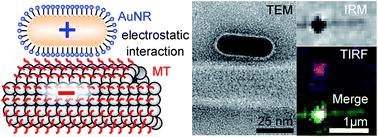当前位置:
X-MOL 学术
›
Nanoscale Adv.
›
论文详情
Our official English website, www.x-mol.net, welcomes your
feedback! (Note: you will need to create a separate account there.)
Polycationic gold nanorods as multipurpose in vitro microtubule markers
Nanoscale Advances ( IF 4.6 ) Pub Date : 2020-07-13 , DOI: 10.1039/d0na00406e Viktoria Wedler 1 , Fabian Strauß 1 , Swathi Sudhakar 1 , Gero Lutz Hermsdorf 1 , York-Dieter Stierhof 1 , Erik Schäffer 1
Nanoscale Advances ( IF 4.6 ) Pub Date : 2020-07-13 , DOI: 10.1039/d0na00406e Viktoria Wedler 1 , Fabian Strauß 1 , Swathi Sudhakar 1 , Gero Lutz Hermsdorf 1 , York-Dieter Stierhof 1 , Erik Schäffer 1
Affiliation

|
Gold nanoparticles are intriguing because of their unique size- and shape-dependent chemical, electronic and optical properties. Gold nanorods (AuNRs) are particularly promising for various sensor applications due to their tip-enhanced plasmonic fields. For biomolecule attachment, AuNRs are often functionalized with proteins. However, by their intrinsic size such molecules block the most sensitive near-field region of the AuNRs. Here, we used short cationic thiols to functionalize AuNRs. We show that the functionalization layer is thin and that these polycationic AuNRs bind in vitro to negatively charged microtubules. Furthermore, we can plasmonically stimulate light emission from single AuNRs in the absence of any fluorophores and, therefore, use them as bleach- and blinkfree microtubule markers. We expect that polycationic AuNRs may be applicable to in vivo systems and other negatively charged molecules like DNA. In the long-term, microtubule-bound AuNRs can be used as ultrasensitive single-molecule sensors for molecular machines that interact with microtubules.
中文翻译:

聚阳离子金纳米棒作为多用途体外微管标记物
金纳米颗粒因其独特的尺寸和形状相关的化学、电子和光学特性而备受关注。金纳米棒 (AuNR) 由于其尖端增强的等离子体场而在各种传感器应用中特别有前景。对于生物分子附着,AuNR 通常用蛋白质进行功能化。然而,由于其固有尺寸,此类分子阻挡了 AuNR 最敏感的近场区域。在这里,我们使用短阳离子硫醇来功能化 AuNR。我们发现功能化层很薄,并且这些聚阳离子 AuNR在体外与带负电的微管结合。此外,我们可以在没有任何荧光团的情况下等离子体激发单个 AuNR 的光发射,因此,将它们用作漂白和免眨眼的微管标记物。我们预计聚阳离子 AuNR 可能适用于体内系统和其他带负电的分子(如 DNA)。从长远来看,微管结合的 AuNR 可用作与微管相互作用的分子机器的超灵敏单分子传感器。
更新日期:2020-09-16
中文翻译:

聚阳离子金纳米棒作为多用途体外微管标记物
金纳米颗粒因其独特的尺寸和形状相关的化学、电子和光学特性而备受关注。金纳米棒 (AuNR) 由于其尖端增强的等离子体场而在各种传感器应用中特别有前景。对于生物分子附着,AuNR 通常用蛋白质进行功能化。然而,由于其固有尺寸,此类分子阻挡了 AuNR 最敏感的近场区域。在这里,我们使用短阳离子硫醇来功能化 AuNR。我们发现功能化层很薄,并且这些聚阳离子 AuNR在体外与带负电的微管结合。此外,我们可以在没有任何荧光团的情况下等离子体激发单个 AuNR 的光发射,因此,将它们用作漂白和免眨眼的微管标记物。我们预计聚阳离子 AuNR 可能适用于体内系统和其他带负电的分子(如 DNA)。从长远来看,微管结合的 AuNR 可用作与微管相互作用的分子机器的超灵敏单分子传感器。










































 京公网安备 11010802027423号
京公网安备 11010802027423号